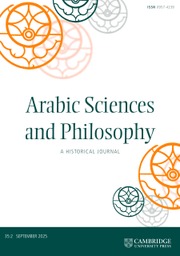L'ALGÈBRE ARABE DANS LES TEXTES HÉBRAÏQUES (II). DANS L'ITALIE DES XVe ET XVIe SIÈCLES, SOURCES ARABES ET SOURCES VERNACULAIRES
Published online by Cambridge University Press: 12 February 2007
Abstract
Until the end of the 14th century, the sources of Hebrew mathematical writings were almost exclusively in Arabic. This was particularly true of texts that contained elements of algebra or algebraic developments. The testimonies we present and analyze here are due to Jewish authors living in Italy, primarily in the 15th century, who made use of the most varied sources, in addition to Arabic: in Castilian, in Italian, and perhaps in Latin. These testimonies constitute both an indication, and a product, of the circulation of Arab algebraic traditions in Renaissance Italy. Simon Moṭoṭ’s book on The Calculation of Algebra stems from the Italian tradition of ‘‘treatises on the abacus’’. Mordekhay Finzi of Mantua is the author of a Hebrew version of the great work on algebra by Abū Kāmil (9th century), as well as of a version, distinct from the preceding, of the Arabic scholar’s introductory exposition. Beginning in 1473, Finzi also translated from Italian to Hebrew the important treatise on algebra by Maestro Dardi of Pisa (1344). We also indicate some 16th century continuations of Hebrew mathematical production, which contain algebraic developments.
- Type
- Research Article
- Information
- Copyright
- 2007 Cambridge University Press
Footnotes
- 3
- Cited by


